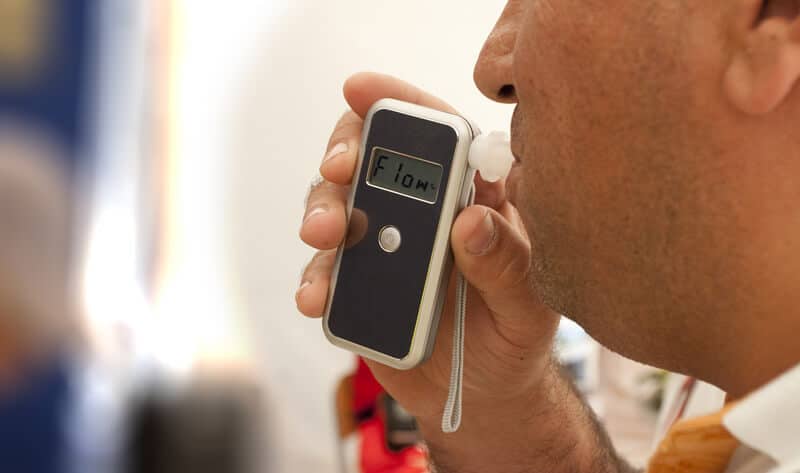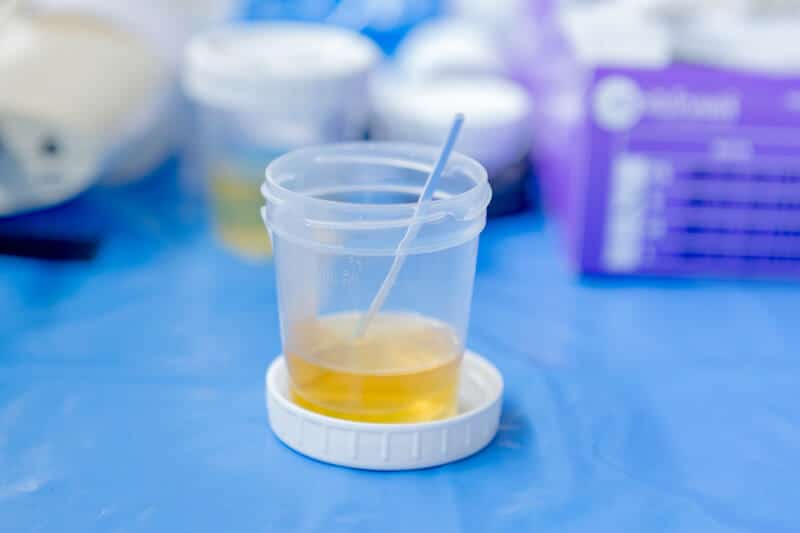Alcohol testing can sometimes be complicated and confusing. There are many types of panels available for alcohol testing. Depending on the needs of the test (for employment versus a court-ordered test), you may only require a breath alcohol test, or you made need alcohol testing with a 5 or 10-panel drug test. A great alcohol test that is easy to get administered is the breath alcohol test or BAT. This test is actually required for DOT testing so the testing is fairly available at occupational health clinics around the United States.
At National Drug Screening, we contract with over 3000 nationwide facilities that offer breath alcohol testing. Blood alcohol testing is an accurate alcohol test to determine impairment. It is an invasive test as blood must be drawn. It is also not always easy to find a qualified phlebotomist to properly draw the blood and properly package it for testing at a laboratory. Urine alcohol testing becomes very complicated, see below for more on urine alcohol testing.

Unlike drug testing, alcohol stays in your system a short time. Generally with blood, urine or breath testing; alcohol cannot be detected after eight hours of alcohol consumption. EtG testing described below detects consumption of alcohol and not actual impairment. se
To purchase an alcohol test panel from National Drug Screening, order online or give us a call at 866-843-4545 to schedule an alcohol and/or drug test near you. Breath alcohol testing is the most often used alcohol test to determine current impairment. EtG alcohol testing does not measure current impairment but does measure recent consumption of alcohol going back up to 80 hours when testing with urine and up to 90 days when testing with hair.
Common Alcohol Test Panels
Breath Alcohol Test or BAT Test Panel
This test measures the breath alcohol concentration which correlates with blood alcohol concentration. The test is performed using an evidential breath testing device (EBT). For DOT testing, the Evidential Breath Testing (EBT) device must be on the NHTSA conforming products list (CPL) for evidential devices and are the only devices you may use to conduct alcohol confirmation tests under DOT regulation 49 CFR Part 40. The testing is performed by a qualified breath alcohol technician commonly called a BAT technician. This is an accurate test. An initial screening test is performed and at a positive level of .02 or above, a second confirmation test is performed after 15 minutes.
Typically a 0.04 breath alcohol level or above is a positive for workplace testing. At 0.02 an employee is sent home not to return back to work until the next day. The levels of 0.02 or higher show recent consumption of alcohol, a level of 0.04 or above shows impairment.
Breath alcohol testing is performed on employees in both DOT and Non-DOT programs. For DOT programs the DOT Alcohol Testing Form is used to record the results of the testing. For Non-DOT testing, the Non-DOT alcohol testing form is used for recording the results of testing. For any breath alcohol testing, the BAT technician should immediately call the employer representative (DER) as soon as a confirmed positive result is recorded.
DOT does also allow a saliva test for alcohol for the initial alcohol screening test only. An approved device must be used. If positive for the alcohol saliva test, a confirmation test using a Evidential Breath Testing (EBT) device must be used and be completed 15 minutes later.
Oral Fluid Alcohol Test Panel
Some laboratories are offering an oral fluid test for Ethyl Alcohol. This can be a stand-alone alcohol test or combined with a drugs of abuse panel. Oral fluid provides a quick and non-invasive specimen for drug and alcohol testing. This is often referred to as a saliva test.
The Quantisal oral fluid collection device is available for lab based alcohol testing with oral fluid. With this testing method there is an excellent correlation between ethanol in breath and ethanol in blood. Oral fluid is ideal for the detection of recent alcohol intake following workplace incidents, within random or monitoring programs and when there is reasonable suspicion of alcohol use.
Blood Alcohol Test Panel
This is an accurate test measuring current impairment with quantitative results. It is difficult to find the appropriate facilities to complete this test properly, it is invasive and it is expensive. A qualified phlebotomist must draw blood for this test. A blood alcohol test measures the amount of alcohol (ethanol) in your body. The amount of alcohol in the blood reaches its highest level about an hour after drinking.
Urine Alcohol Test Panel
If requested standard laboratory testing of urine can detect ethanol which is another name for alcohol. This can be a stand-alone test for ethanol alcohol or added to a standard drug test such as a 5 panel or 10 panel. This testing is common for court ordered or probation drug and alcohol testing. Urine alcohol testing is prohibited for DOT drug and alcohol testing programs. For all employers, National Drug Screening strongly recommends against urine ethanol testing of applicants or employees. The test does not measure current consumption or current impairment. This is a legal drug that employees can consume after work hours. The urine alcohol test for ethanol can also produce “false positives” for individuals with certain medical conditions (e.g., diabetes) and fail to provide adequate quantitative levels for reporting.
The Alcohol (Ethanol) urine test looks for recent use of alcohol. Alcohol is typically detectable in the urine for several hours up to 24 hours. The length of time alcohol can be detectable varies by person depending on factors such as metabolism, activity level during and after alcohol consumption and how much food was consume. The biggest issue with urine alcohol testing is you might get a positive from someone who had some wine with dinner the evening before the at work test.
ETG Alcohol Test Urine Panel
An EtG test advantage is that EtG remains in the body long after all the alcohol is gone. ETG is Ethyl Glucuronide which is a by-product or direct metabolite of alcohol as it breaks down in the body. In urine, ETG can be detected up to 80 hours as it is stored in the body for a longer period of time. This test will not detect current impairment but will detect that alcohol was consumed in the past 80 hours. This test is particularly useful for individuals in rehabilitation programs and in the criminal justice system to make sure that the individual is not consuming alcohol.
ETG Alcohol Test Hair Panel
Testing with hair has a longer lookback period – up to 90 days. A metabolite of alcohol called ETG can show in hair after about 7 days and up to about 90 days. This ETG Alcohol Hair Panel test is used to determine if the individual has consumed alcohol in the past 90 days. It should not be used to detect a one-time consumption of alcohol but EtG hair tests are generally best used only to determine whether a person has used alcohol chronically over a period of time. 1.5 inches of head hair is required for this testing which will give the up to 90 day look back period. The 1.5 inch sample of about 200 strands of hair (about the size of a #2 pencil) closest to the scalp will give 100mg of hair, the ideal sample for screening and confirmation.
The ETG test for hair should not be used for a workplace test unless the individual is in a zero tolerance alcohol treatment program. ETG alcohol testing with hair is often used in legal and court cases as well as child custody cases to determine an individual is not consuming alcohol. Commonly called hair follicle testing, the hair testing for alcohol for drugs is not testing the hair follicle. The hair is cut at the scalp, as close as possible to the scalp to determine the most recent drug or alcohol use.
Instant Alcohol Testing Panel
There are products available that can be used to perform an initial screen for alcohol, these are called instant saliva alcohol testing devices. It is important to note that when utilizing these products, a confirmation test is absolutely necessary with an Evidential Breath Testing (EBT) device when the initial screening result is 0.02 or higher. These tests are approved for DOT testing for the initial screening only and should not be used without the availability of a confirmation test method; the Evidential Breath Testing (EBT) device.
Q.E.D. Saliva Alcohol Test
This is a CLIA-waived and DOT-approved, on-site, rapid, low-cost alternative to breath or blood testing. Q.E.D. is easy to administer and provides quantitative results comparable to a blood test. Q.E.D. is ideal for use in workplace, criminal justice, drug and alcohol treatment centers and clinical setting screening programs, among others. This test offers a fast and simple alcohol testing process when the result is negative. These tests come minimum 10 tests to a box at $7.95 per test including shipping.
Alco-Screen 02
A rapid, highly sensitive method to detect the presence of alcohol in saliva and provide an approximation of relative blood alcohol concentration. This is a simple, one-step, 2 minute test that requires no instrumentation, calibration or special training to be used effectively. It is convenient enough to be used any time, and in any place. Alco-Screen 02 has been tested and approved by the US Department of Transportation (DOT) for required testing of all transportation and safety sensitive employees (DOT) when results are negative at less than 0.02%. Minimum order is 24 tests and sells for $2.95 per test including shipping.
Issues with Urine Alcohol Testing
Urine alcohol testing other than ETG alcohol testing does not show current impairment. In fact the individual being tested may have has a few drinks over the weekend and test positive on a urine alcohol test on Monday. Did they violate any company policy – most likely the answer is NO. It is important to utilize breath alcohol testing to determine impairment or prohibited use of alcohol. A positive urine alcohol test is not indicative of alcohol impairment nor does it definitively indicate beverage alcohol consumption. Individuals that are diabetic and have a bacterial infection can have fermentation and show positive on a urine-ethanol test which would never be a violation of company policy. National Drug Screening strongly recommends against urine ethanol testing of applicants or employees.
When to Use Alcohol Testing
For employers, the best time to perform alcohol testing is when you have reasonable suspicion that a worker is impaired or intoxicated and also for post-accident testing. For either situation, call out a tester to perform the testing or bring the individual to the clinic for the alcohol testing. You do not want to let this person drive when there is the possibility they are intoxicated. Safety first, but always test when you have reasonable suspicion. You need the documentation of the test results in case there is any adverse action to take. Always document everything very carefully.
National Drug Screening has available drug and alcohol specialists for your alcohol testing needs. Always call for expert assistance For any drug test and alcohol test it is important that the right test is done in the right way. Always consult with an exper







